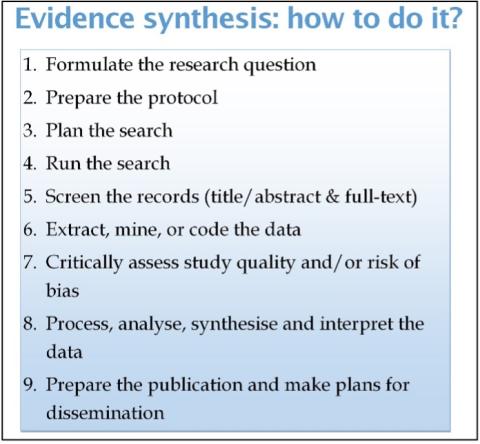In an era when fake news and AI-created photos and videos populate the digital world, the ability to recognise what is valid and solid evidence (and what is not) is increasingly important. This is particularly relevant in medical and healthcare-related disciplines (including psychology), because work in these fields directly affects the lives and well-being of many people. Students and researchers need to be able to bring together and assess data and results from multiple sources – synthesising evidence – to come to valid, evidenced conclusions and use them to inform their work.
In this article, I will discuss what evidence synthesis is, why it should be incorporated into undergraduate curricula and postgraduate training, and how free training can be sought and accessed.
What is evidence synthesis?
Evidence synthesis is defined as the process of systematically selecting, summarising and appraising data from multiple sources. It involves gathering data from past studies to draw conclusions, assess the support or refutation of theories, and identify research gaps that need addressing before solid conclusions can be drawn. The importance of evidence synthesis in fields such as psychology, psychiatry and healthcare has grown significantly. Studies such as systematic reviews and meta-analyses are in fact instrumental in helping clinicians, policymakers and researchers make informed decisions and recommendations for clinical practice. For example, in the UK, experts within the National Institute for Health and Care Excellence (NICE) consult published evidence synthesis studies (or conduct their own) to develop clinical guidelines and evidence-based recommendations for health and care.
Why should I learn about evidence synthesis?
Knowledge about evidence synthesis has benefits for both students and educators. As a student (including undergraduates), mastery of evidence synthesis can significantly enhance your academic profile. If you have expertise in conducting these studies, highlight it on your CV. Attending training programmes on specific evidence synthesis methodologies can also expand your knowledge and network with potential co-authors and collaborators for future publications and projects.
- Three ways libraries are championing the open access movement
- Maximise your research impact through interdisciplinary collaboration
- We set up a thought leadership programme to amplify PhD research reach
For lecturers, evidence synthesis can become a component of your teaching. Consider creating new modules or workshops for master’s and PhD students specifically focused on evidence synthesis. In my experience, these offerings have been in high demand, indicating a strong student interest in learning these skills at university.
If you’re not an expert in evidence synthesis, you can still integrate it into your lectures using meta-analyses, umbrella reviews or narrative reviews as references to support concepts or theories. This approach will help students understand the importance of evidence synthesis and encourage them to consult these types of studies when working on their essays and research projects, ultimately improving the quality and value of their work.
How to conduct evidence synthesis – and what do I need?
Evidence synthesis can be done by using systematic or non-systematic approaches. When you conduct evidence synthesis systematically (for example, when you do a systematic review instead of a literature review), there are precise steps you follow (see Figure 1).
First, formulate the research question (for example, what is the population, intervention or outcome of interest?) and prepare the protocol. Then, retrieve the papers from relevant databases based on your discipline and screen them one by one. Data extraction or coding and assessment of study quality and risk of bias will follow. All these steps require you to be familiar with the chosen area of research and the specific methodology you are using (I’ve included suggestions about free training opportunities in evidence synthesis further down in this article).

Synthesise the data to find the bigger picture and address questions such as: how many studies did I find? What do they look like in terms of design, sample/study characteristics and main findings? Are most studies in favour of or against my hypotheses? Report results with meta-analysis or thematic synthesis, if applicable. Finally, prepare infographics, lay summaries or videos, explaining your study and its importance in simple terms.
Evidence synthesis can be done anywhere in the world and is cost effective. I am based in the UK, but I have worked with researchers from Italy, Spain, France, Brazil, the USA, Canada, Malaysia, Singapore and South Korea. I recommend working with other students or academics with expertise in evidence synthesis; they will mentor and guide you through the stages of the project. You can use online software for screening (such as Rayyan or Covidence) or data extraction (Google Sheets). Accessing the full text of some papers could be challenging, especially if you are not affiliated with any university or research centre, or if your institution is not well resourced. Networking with people working at different institutions, requesting inter-library loans or contacting the authors can help to overcome this hurdle.
How can I learn to do evidence synthesis?
Courses and online guides can help educators, students and researchers learn about evidence synthesis. Online and in-person evidence synthesis courses can be too advanced or costly for some students, especially those in resource-limited institutions or low- to middle-income countries. However, free training opportunities are available.
If you are new to evidence synthesis or unsure about the difference between a literature review and a systematic review, watch this three-minute video: Evidence Synthesis – What is it and why do we need it?
Some of you might be thinking about doing a systematic review or meta-analysis, but there are many other ways to synthesise evidence. The University of Melbourne Medicine, Dentistry and Health Sciences library provides a comprehensive online guide to review types to help you better understand these methods (including reviews of reviews and qualitative methods for evidence synthesis).
If you are interested in learning more about systematic reviews and meta-analysis and the specific steps to completing such projects, watch How to Conduct a Systematic Review and Write-Up in 7 Steps or join the online training course Introduction to Systematic Review and Meta-Analysis.
For those who have started working on a systematic review, the Cochrane Handbook for Systematic Reviews of Interventions or the e-book Doing Meta-Analysis with R: A Hands-On Guide dive deeply into the methodological aspects of these techniques. If you have funding available to support your training, type “training evidence synthesis 2024” into Google to search for courses or workshops.
Have I provided sufficient evidence to persuade you of the importance of evidence synthesis for students and researchers working in psychology, medicine or healthcare? I believe so, but what do you think?
Alessio Bellato is a lecturer in child and adolescent mental health at the University of Southampton and an honorary assistant professor of psychology at the University of Nottingham Malaysia.
If you would like advice and insight from academics and university staff delivered direct to your inbox each week, sign up for the Campus newsletter.




comment